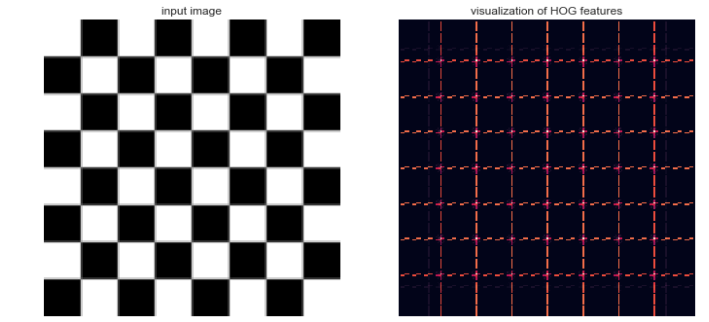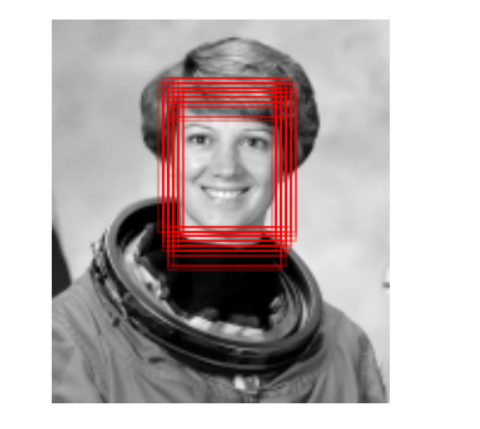今天要來介紹Image Features,並且如何實作特徵選取、人臉辨識,目前影像辨識的支援模組及開放的函式有相當多,所以在實作上可以方便又快速,那我們今天來介紹利用方向梯度直方圖(Histogram of Oriented Gradient, HOG)來提取特徵。
%matplotlib inline
import matplotlib.pyplot as plt
import seaborn as sns; sns.set()
import numpy as np
HOG的演算過程:
想要了解「伽瑪校正Gamma Correction」內容參考:https://blog.csdn.net/lichengyu/article/details/8457425
from skimage import data, color, feature
import skimage.data
image = color.rgb2gray(data.checkerboard())
hog_vec, hog_vis = feature.hog(image, visualise=True)
fig, ax = plt.subplots(1, 2, figsize=(12, 6),
subplot_kw=dict(xticks=[], yticks=[]))
ax[0].imshow(image, cmap='gray')
ax[0].set_title('input image')
ax[1].imshow(hog_vis)
ax[1].set_title('visualization of HOG features');
skimage的相關資料可參考scikit-image:http://scikit-image.org/docs/dev/api/skimage.html

from sklearn.datasets import fetch_lfw_people
faces = fetch_lfw_people(data='``` 資料路徑 ```'))
positive_patches = faces.images
positive_patches.shape
from skimage import data, transform
imgs_to_use = ['camera', 'text', 'coins', 'moon',
'page', 'clock', 'immunohistochemistry',
'chelsea', 'coffee', 'hubble_deep_field']
images = [color.rgb2gray(getattr(data, name)())
for name in imgs_to_use]
from sklearn.feature_extraction.image import PatchExtractor
def extract_patches(img, N, scale=1.0, patch_size=positive_patches[0].shape):
extracted_patch_size = tuple((scale * np.array(patch_size)).astype(int))
extractor = PatchExtractor(patch_size=extracted_patch_size,
max_patches=N, random_state=0)
patches = extractor.transform(img[np.newaxis])
if scale != 1:
patches = np.array([transform.resize(patch, patch_size)
for patch in patches])
return patches
negative_patches = np.vstack([extract_patches(im, 1000, scale)
for im in images for scale in [0.5, 1.0, 2.0]])
negative_patches.shape
from itertools import chain
X_train = np.array([feature.hog(im)
for im in chain(positive_patches,
negative_patches)])
y_train = np.zeros(X_train.shape[0])
y_train[:positive_patches.shape[0]] = 1
X_train.shape
from sklearn.naive_bayes import GaussianNB
from sklearn.cross_validation import cross_val_score
cross_val_score(GaussianNB(), X_train, y_train)
from sklearn.svm import LinearSVC
from sklearn.grid_search import GridSearchCV
grid = GridSearchCV(LinearSVC(), {'C': [1.0, 2.0, 4.0, 8.0]})
grid.fit(X_train, y_train)
grid.best_score_
model = grid.best_estimator_
model.fit(X_train, y_train)
test_image = skimage.data.astronaut()
test_image = skimage.color.rgb2gray(test_image)
test_image = skimage.transform.rescale(test_image, 0.5)
test_image = test_image[:160, 40:180]
plt.imshow(test_image, cmap='gray')
plt.axis('off');
def sliding_window(img, patch_size=positive_patches[0].shape,
istep=2, jstep=2, scale=1.0):
Ni, Nj = (int(scale * s) for s in patch_size)
for i in range(0, img.shape[0] - Ni, istep):
for j in range(0, img.shape[1] - Ni, jstep):
patch = img[i:i + Ni, j:j + Nj]
if scale != 1:
patch = transform.resize(patch, patch_size)
yield (i, j), patch
indices, patches = zip(*sliding_window(test_image))
patches_hog = np.array([feature.hog(patch) for patch in patches])
patches_hog.shape
labels = model.predict(patches_hog)
labels.sum()
fig, ax = plt.subplots()
ax.imshow(test_image, cmap='gray')
ax.axis('off')
Ni, Nj = positive_patches[0].shape
indices = np.array(indices)
for i, j in indices[labels == 1]:
ax.add_patch(plt.Rectangle((j, i), Nj, Ni, edgecolor='red',
alpha=0.3, lw=2, facecolor='none'))

Scikit-Learn在這邊講解的差不多了,這裡來整理一下:![]()
